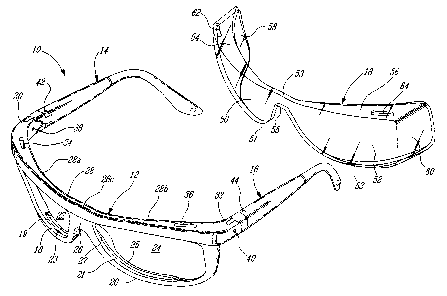Some of the information on this Web page has been provided by external sources. The Government of Canada is not responsible for the accuracy, reliability or currency of the information supplied by external sources. Users wishing to rely upon this information should consult directly with the source of the information. Content provided by external sources is not subject to official languages, privacy and accessibility requirements.
Any discrepancies in the text and image of the Claims and Abstract are due to differing posting times. Text of the Claims and Abstract are posted:
| (12) Patent Application: | (11) CA 2337928 |
|---|---|
| (54) English Title: | PROTECTIVE EYEGLASS ASSEMBLY |
| (54) French Title: | ENSEMBLE DE LUNETTES PROTECTRICES |
| Status: | Deemed Abandoned and Beyond the Period of Reinstatement - Pending Response to Notice of Disregarded Communication |
| (51) International Patent Classification (IPC): |
|
|---|---|
| (72) Inventors : |
|
| (73) Owners : |
|
| (71) Applicants : |
|
| (74) Agent: | NORTON ROSE FULBRIGHT CANADA LLP/S.E.N.C.R.L., S.R.L. |
| (74) Associate agent: | |
| (45) Issued: | |
| (22) Filed Date: | 2001-02-23 |
| (41) Open to Public Inspection: | 2002-08-23 |
| Availability of licence: | N/A |
| Dedicated to the Public: | N/A |
| (25) Language of filing: | English |
| Patent Cooperation Treaty (PCT): | No |
|---|
| (30) Application Priority Data: | None |
|---|
The protective eyeglass assembly described comprises a frame having right and
left portions defining respective right and left apertures and a central
bridging
portion, a pair of ear stems respectively mounted at an upper edge extremity
of
the right and left portions and a protective lens piece defining an unitary
arcuate
body adapted to be mounted to and rearwardly of the lens piece between the
upper and lower edges of the frame. The lower edge of the lens supporting
surface of the frame has a retaining wall for retaining the lens therein while
the
upper edges of the frame and the lens piece have cooperating portions to
secure
the lens to the frame. The frame is made of flexible plastic material to
enable a
snap-in engagement and a snap-out disengagement of the lens to and from the
frame.
Note: Claims are shown in the official language in which they were submitted.
Note: Descriptions are shown in the official language in which they were submitted.

2024-08-01:As part of the Next Generation Patents (NGP) transition, the Canadian Patents Database (CPD) now contains a more detailed Event History, which replicates the Event Log of our new back-office solution.
Please note that "Inactive:" events refers to events no longer in use in our new back-office solution.
For a clearer understanding of the status of the application/patent presented on this page, the site Disclaimer , as well as the definitions for Patent , Event History , Maintenance Fee and Payment History should be consulted.
| Description | Date |
|---|---|
| Inactive: IPC from MCD | 2006-03-12 |
| Inactive: IPC from MCD | 2006-03-12 |
| Inactive: IPC from MCD | 2006-03-12 |
| Time Limit for Reversal Expired | 2006-02-23 |
| Application Not Reinstated by Deadline | 2006-02-23 |
| Deemed Abandoned - Failure to Respond to Maintenance Fee Notice | 2005-02-23 |
| Appointment of Agent Requirements Determined Compliant | 2002-09-20 |
| Inactive: Office letter | 2002-09-20 |
| Inactive: Office letter | 2002-09-20 |
| Revocation of Agent Requirements Determined Compliant | 2002-09-20 |
| Revocation of Agent Request | 2002-08-30 |
| Appointment of Agent Request | 2002-08-30 |
| Application Published (Open to Public Inspection) | 2002-08-23 |
| Inactive: Cover page published | 2002-08-22 |
| Inactive: Office letter | 2002-03-20 |
| Letter Sent | 2002-03-20 |
| Letter Sent | 2002-03-20 |
| Inactive: Office letter | 2002-03-20 |
| Letter Sent | 2002-03-19 |
| Inactive: Office letter | 2002-02-26 |
| Letter Sent | 2002-02-26 |
| Inactive: First IPC assigned | 2001-05-08 |
| Inactive: IPC assigned | 2001-05-08 |
| Inactive: IPC assigned | 2001-05-08 |
| Inactive: Inventor deleted | 2001-03-26 |
| Letter Sent | 2001-03-26 |
| Inactive: Filing certificate - No RFE (French) | 2001-03-26 |
| Inactive: Applicant deleted | 2001-03-26 |
| Inactive: Applicant deleted | 2001-03-26 |
| Application Received - Regular National | 2001-03-26 |
| Abandonment Date | Reason | Reinstatement Date |
|---|---|---|
| 2005-02-23 |
The last payment was received on 2004-02-02
Note : If the full payment has not been received on or before the date indicated, a further fee may be required which may be one of the following
Patent fees are adjusted on the 1st of January every year. The amounts above are the current amounts if received by December 31 of the current year.
Please refer to the CIPO
Patent Fees
web page to see all current fee amounts.
| Fee Type | Anniversary Year | Due Date | Paid Date |
|---|---|---|---|
| Registration of a document | 2001-02-23 | ||
| Application fee - standard | 2001-02-23 | ||
| Registration of a document | 2002-01-30 | ||
| Registration of a document | 2002-02-05 | ||
| Registration of a document | 2002-02-06 | ||
| MF (application, 2nd anniv.) - standard | 02 | 2003-02-24 | 2003-02-07 |
| MF (application, 3rd anniv.) - standard | 03 | 2004-02-23 | 2004-02-02 |
Note: Records showing the ownership history in alphabetical order.
| Current Owners on Record |
|---|
| CABOT SAFETY INTERMEDIATE CORP. |
| LEADER INDUSTRIES INC. |
| Past Owners on Record |
|---|
| ERIC LAPOINTE |
| LUC BLANCHETTE |